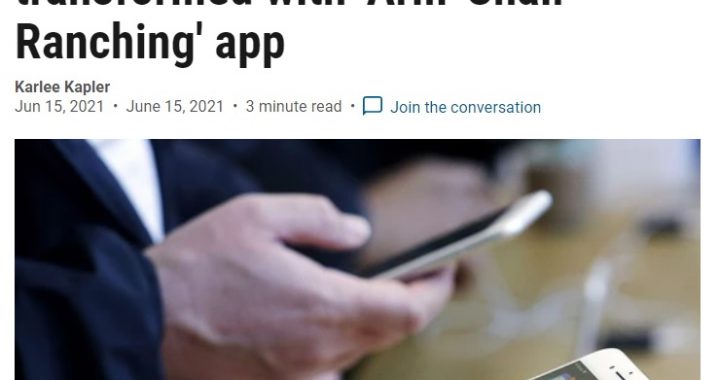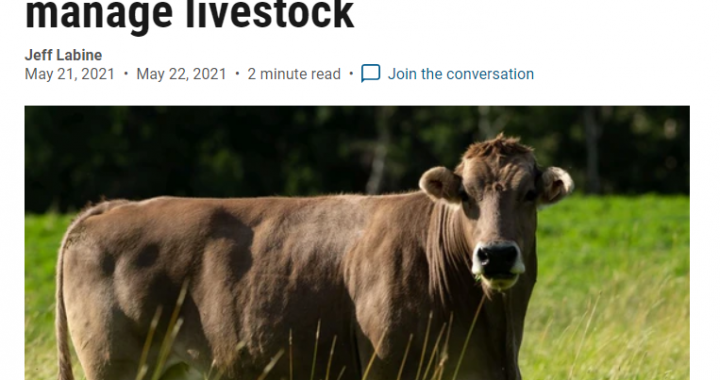 The Smart Agriculture and Food Digitization and Automation Challenge was launched by Alberta Innovated to funds projects that are developing smart technologies to increase productivity on farms. The Arm-Chair Rancher is one of 8 projects that were successful.
The Smart Agriculture and Food Digitization and Automation Challenge was launched by Alberta Innovated to funds projects that are developing smart technologies to increase productivity on farms. The Arm-Chair Rancher is one of 8 projects that were successful.
Category Archives: News
Frontline Farming Canada talks beef genomics with Gentec’s John Basarab
 Diane Finstad of Frontline Farming Canada met with Dr. John Basarab (Gentec’s Head of Beef Operations) to discuss hybrid vigour and its potential to improve the health and sustainability of Alberta’s beef herds.
Diane Finstad of Frontline Farming Canada met with Dr. John Basarab (Gentec’s Head of Beef Operations) to discuss hybrid vigour and its potential to improve the health and sustainability of Alberta’s beef herds.
The interview is airing on RFD-TV, available through Shaw’s satellite service, Telus Optik and rural cable companies. You can tune in on Fridays ats 8:00 pm. Sunday 8 am, Mondays 5:30 am and Tuesdays 8:30 pm throughout the month of May. The interview will also be airing on the Cowboy Channel Tuesday’s at 3:30 pm.
Gentec’s Kira Macmillan discusses the “Arm-Chair Rancher” with 770 CHRQ The Drive
 While a fully functioning app is still a long way off, the Arm-Chair Rancher team is working with beef producers to ensure this app will bring value to Alberta’s ranches.
While a fully functioning app is still a long way off, the Arm-Chair Rancher team is working with beef producers to ensure this app will bring value to Alberta’s ranches.
Listen to the interview here.
Gentec’s CEO Graham Plastow speaks with the Edmonton Journal about the “Arm-Chair Rancher”
 The Arm-Chair Rancher aims to support beef producers in making decisions on their farm with tailored recommendations and scenario planning for every area of their operation.
The Arm-Chair Rancher aims to support beef producers in making decisions on their farm with tailored recommendations and scenario planning for every area of their operation.
Read the full article here.
Alberta Innovates announces funding for Gentec’s “Arm-Chair Rancher” project
 Livestock Gentec, partnered with the University of Alberta and Beefbooster, was awarded $481,000 to develop an app to harness on-farm and industry data and use machine learning to generate guiding scenarios and predictions for optimal herd and farm management. Funding was awarded through Alberta Innovates “Smart Agriculture and Food Digitization and Automation Challenge”.
Livestock Gentec, partnered with the University of Alberta and Beefbooster, was awarded $481,000 to develop an app to harness on-farm and industry data and use machine learning to generate guiding scenarios and predictions for optimal herd and farm management. Funding was awarded through Alberta Innovates “Smart Agriculture and Food Digitization and Automation Challenge”.
Read the full announcement here.
The Path to New Zealand
At our 2017 Livestock Gentec conference William Torres of Cattleland Feedyards focused on Pursuing Evidence-based Outcomes in the Beef Industry. The obstacles can be many… and varied… and driven by producer and end-user perceptions. Often, adopting best evidence-based practices is slowed by not knowing what these best practices are and how to apply them, or by a lack of coordination as to how to share their implementation, costs, and benefits across the various links in the supply chain. Just as often, however, difficulties arise due to nostalgia on the part of the producer aiming to preserve tradition and operate the ranch like “Grandpa” did, and on the part of the consumer seeking “natural” food free of many of today’s productivity-improving technologies that are necessary for the producer to remain in business.
However, several forces are converging to spur change. Environmental pressures and an increasing desire to ensure sustainable production are opening the door slightly and allowing scientific advances to pass through, as is the need to farm in the most efficient manner to ensure that nutritious food is also affordable food.
Stepping back from the idea that industry integration is a requirement, William focused instead on coordination, outlining some of the conditions that facilitate the use of genomics technologies with respect to sorting and managing animals at the feedlot level, and on areas where there is consensus on the social and economic benefit of pursuing change. These areas include the use of pain management tools for castration and de-horning procedures and the appropriate use of antibiotics to ensure animal welfare while preventing the development of antimicrobial resistance. When used as part of a disciplined pre-conditioning protocol, these measures help industry address animal welfare concerns and help optimize producer efforts and profitability.
Although not completely reflected in the edited version, William also spoke of the need to engage with those who disagree with you or don’t necessarily think like you, if only because they are often your customer. At its very worst, evidence allows us as an industry to do what society expects of us (even when society is ill-informed or we don’t agree with the direction of change) in a manner that imposes the least burden on us as producers. On more moderate ground, evidence also allows us as an industry to defend practices that are poorly understood, such as making the case that the use of medications in treating sick animals is the humane thing to do. At their best, evidence-based practices allow producers to make informed decisions on how to collaborate within the system to deliver the best possible beef in the most efficient and sustainable manner.
That said (and as an editor’s aside), there are also instances when the public shines a light on an industry practice that, while historic in precedent, is hard to justify today. Two practices often mentioned in the lay press are dehorning and branding. Industry is responding through the use of pain control medication in dehorning procedures and the use of genomics to select for homozygous polled bulls. Genomics also has the potential to supplant branding through the combination of the existing animal ID practices with DNA-based traceability markers. To view a summary of William’s talk, please click here.
Pursuing Evidence-based Outcomes in the Beef Industry
At our 2017 Livestock Gentec conference William Torres of Cattleland Feedyards focused on Pursuing Evidence-based Outcomes in the Beef Industry. The obstacles can be many… and varied… and driven by producer and end-user perceptions. Often, adopting best evidence-based practices is slowed by not knowing what these best practices are and how to apply them, or by a lack of coordination as to how to share their implementation, costs, and benefits across the various links in the supply chain. Just as often, however, difficulties arise due to nostalgia on the part of the producer aiming to preserve tradition and operate the ranch like “Grandpa” did, and on the part of the consumer seeking “natural” food free of many of today’s productivity-improving technologies that are necessary for the producer to remain in business.
However, several forces are converging to spur change. Environmental pressures and an increasing desire to ensure sustainable production are opening the door slightly and allowing scientific advances to pass through, as is the need to farm in the most efficient manner to ensure that nutritious food is also affordable food.
Stepping back from the idea that industry integration is a requirement, William focused instead on coordination, outlining some of the conditions that facilitate the use of genomics technologies with respect to sorting and managing animals at the feedlot level, and on areas where there is consensus on the social and economic benefit of pursuing change. These areas include the use of pain management tools for castration and de-horning procedures and the appropriate use of antibiotics to ensure animal welfare while preventing the development of antimicrobial resistance. When used as part of a disciplined pre-conditioning protocol, these measures help industry address animal welfare concerns and help optimize producer efforts and profitability.
Although not completely reflected in the edited version, William also spoke of the need to engage with those who disagree with you or don’t necessarily think like you, if only because they are often your customer. At its very worst, evidence allows us as an industry to do what society expects of us (even when society is ill-informed or we don’t agree with the direction of change) in a manner that imposes the least burden on us as producers. On more moderate ground, evidence also allows us as an industry to defend practices that are poorly understood, such as making the case that the use of medications in treating sick animals is the humane thing to do. At their best, evidence-based practices allow producers to make informed decisions on how to collaborate within the system to deliver the best possible beef in the most efficient and sustainable manner.
That said (and as an editor’s aside), there are also instances when the public shines a light on an industry practice that, while historic in precedent, is hard to justify today. Two practices often mentioned in the lay press are dehorning and branding. Industry is responding through the use of pain control medication in dehorning procedures and the use of genomics to select for homozygous polled bulls. Genomics also has the potential to supplant branding through the combination of the existing animal ID practices with DNA-based traceability markers. To view a summary of William’s talk, please click here.





